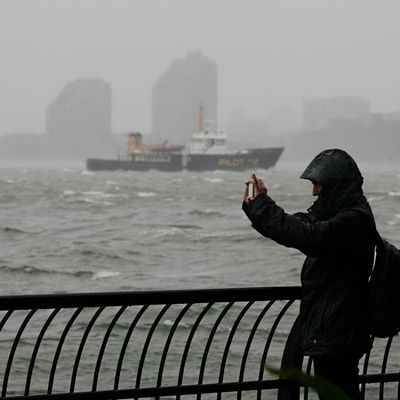
It all started with a hashtag. When chatter about Sandy, then a tropical storm, first blew into the northeast, it was quickly affixed with a catchy moniker — and by a government forecaster no less, who declared that the “hybrid vortex” of a hurricane and a winter storm (not to mention Halloween and a full moon) was “inviting perhaps a ghoulish nickname for the cyclone along the lines of ‘Frankenstorm,’ an allusion to Mary Shelley’s Gothic creature of synthesized elements.” In the days since, the #Frankenstorm went from trending topic to terrible reality, killing more than a dozen people, flooding much of New York City, and leaving hundreds of thousands without power or transportation.
As it unfolded, a different confluence of factors — namely the simultaneous rise and ubiquity of Twitter, YouTube, and Instagram, along with the endless churn of the 24-hour news cycle — combined to create another hybrid vortex in which the virtual community experienced the storm both in seclusion and all together. We all watched through our screens first, interacting all the while, and out the window second.
From the Super Bowl to the movie theater shootings in Aurora, social media has altered the collective experience of every major news event, providing platforms for both insta-reactions and commentary, as well as news gathering and sharing (and with them, the potential for errors and embarrassment). While September 11 and the blackout of 2003 predated these systems, and the near-misses of Hurricane Irene and the east coast earthquake left the various services inundated with glib jokes, Hurricane Sandy represents New York City first’s social media disaster, in which the most current and continuous stream of information flowed not from television, radio, or other forms of transitional media, but online, and in line with the long-hyped promise of citizen journalism, often from amateurs.
Already, this hurricane is being marked as a coming-of-age moment for Instagram, the photo-sharing service acquired by Facebook last year, which saw uploads of up to ten images per second tagged #Sandy during the storm. Those images spread mostly on Twitter and Facebook, while sites like #Instacane rounded them all up, and old-school media outfits like Time, The Wall Street Journal, and the New York Times — all relying in part on the social-media-optimized live-blog format — were forced to cull from these pools, doing their best to verify authenticity along the way.
It certainly wasn’t seamless: Fake photos of sharks, seals, and overly ominous skies whipped around the web all day, and continue to do so despite being debunked. But the real pictures are just as stunning, and they have typically floated to the top, as efforts to delineate between true and false became its own online cottage industry in the hurricane coverage.
The same goes for Twitter rumors, from the weeklong MTA shutdown to the flooding of the New York Stock Exchange, both of which were promptly quashed on the same medium they were born. As John Herrman of Buzzfeed writes, “Twitter is a fact-processing machine on a grand scale, propagating then destroying rumors at a neck-snapping pace. To dwell on the obnoxiousness of the noise is to miss the result: That we end up with more facts, sooner, with less ambiguity.”
There’s an emotional component as well. The virtual campfire of social media counters the isolation of being evacuated, quarantined, and cut off from all transit by hosting a congregation of common experience. Watching live network coverage on television or reading a newspaper account the next morning are both narrow and passive in a way that the Internet is not; instead of maxing out at the spectacle of a windblown newscaster, online the channels are infinite and customizable, the vantage points varied. Participating in and collecting up-to-the-second knowledge both require some degree of skill when it comes to sorting the real from the fake and the dire from the fearmongering, but both can help to quell the fear that comes from being at the mercy of outside forces; being cut off from the world can be the scariest part. And so when the power does go out, as it did for so many last night, it’s now normal to reach first for a cell phone, not a candle, both for the light and for the comfort of knowing you’re not alone.





























